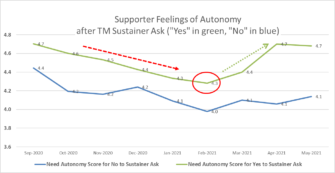Does the donor sign up experience impact sustainer retention?
If you think donor experience matters to sustainer retention then the vague term needs to be broken down into specifics and we need to get more precise.
Let’s start with context. Consider a telefundraising campaign to convert digital petition leads to sustainer.
Mental exercise: Name two parts of the call experience that have a statistically significant impact on sustainer attrition in the first 90 days.
Did your list include ask amount? And does retention go up or down as the ask amount goes up?
Ask amount matters, a lot. But, it’s a counter-intuitive until it isn’t. As ask amount goes up, so goes retention. The rub is that ask amount goes down during the call conditional on getting supporter “no’s” or reluctance to the starting ask. All that extra pushing and cajoling corresponds to signing up supporters who are less likely to stick around.
The smart Agitator reader has already noted, “but, some of those do stick around and we make money on them in spite of the higher attrition for the group.”
That may be true though I’d wager all the money I don’t have that you aren’t breaking out your new TM converted sustainer retention by how many no’s they gave on the TM call before saying yes. Maybe (big maybe) you are looking at by ask amount but I’d wager half the money I don’t have against that.
But for conversation, let’s assume this group of “no before saying yes” folks are still profitable. Is there a way to have our cake and eat it too or at least eat some of it?
The repeat asks can have the effect of undermining the subconscious feeling of autonomy and control by the human being on the receiving end a of that experience. We know from all our testing and measuring that as autonomy goes down, retention goes down. But what we do we do about this? If it’s just a measuring stick to nowhere then it’s not a metric worth measuring.
This is real data showing supporter feelings of autonomy after a TM sustainer conversion call tracked over time and broken out by those whose final disposition was “yes” to the sustainer ask (in green) and those who ended the call with a “no” (blue line).
Two macro take-aways.
- Feelings of autonomy impact conversion – blue line is lower than the green line. This is cause and effect. I felt like the fundraiser was undermining my sense of control and reactance kicked in, I was going to say ‘no’ over and over (if needed) to try and regain a key, psychological need.
- Something changed the green (and less so, blue) trend line and it was a positive change.
Let’s dig in on pt. 2. It wasn’t random. It was an intervention with the agency on the part of the charity (with our guidance) to stop the negative downward trend of supporter autonomy. As it turns out, the agency had a new manager whose ethos was akin to Glengarry Glen Ross, always-be-closing.
That hurts conversion and retention. But, we were able to make relatively minor re-training adjustments (down to fundraiser level which is the next level down we have for this data) to increase supporter feelings of autonomy that increased conversion and retention. Cause meet effect…

It’s cliche but true, what gets measured gets managed but too much of what matters doesn’t get measured at all and too much of what gets measured is done because it’s simple, easy and the way things have always been done but with serving no useful, business improvement purpose.
Kevin


